Panasonic SC-HTB480 Review
Panasonic SC-HTB480 Review
A discreet 2.1-channel soundbar with built-in Bluetooth and wireless subwoofer
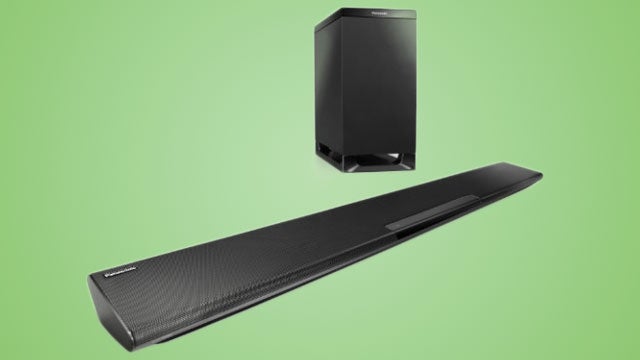
Verdict
Pros
- Discreet Delta Form design
- Robust build quality
- Sounds loud and bassy
Cons
- Hard, brash sound
- Sockets tricky to access
- Upward-facing LED display
Key Specifications
- Review Price: £287.99
- 250W quoted power output
- Built-in Bluetooth with NFC
- Dolby Digital and DTS decoding
- Dolby Virtual Speaker, 3D Surround mode and 3D Clear Mode Dialog
- Tabletop or wall mounting
What is the Panasonic SC-HTB480?
The SC-HTB480 is a soundbar and wireless subwoofer designed to give lacklustre TV sound a much-needed boost. It’s a 2.1-channel system positioned below the flagship 5.1-channel SC-HTB880 and 3.1-channel SC-HTB680.
Panasonic has had mixed fortunes in the soundbar market, offering impressive feature lists and designs but often letting the side down on sound quality – let’s see if the SC-HTB480 can turn things around.
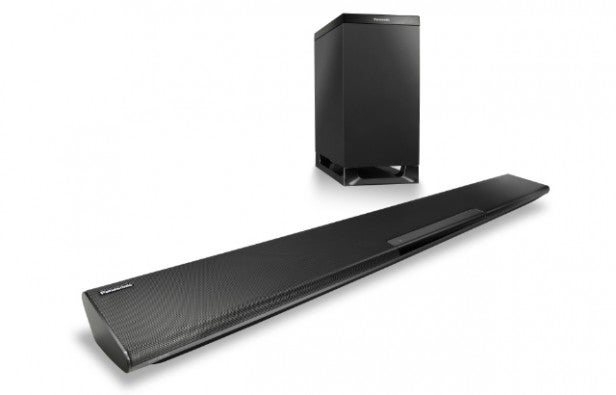
Panasonic SC-HTB480 – Design and Connections
Described as a ‘Delta Form’ design, the soundbar’s slim, sloping body will sit on top of your TV stand without blocking the screen. Not only does the sloping top panel look cool, but it also allows Panasonic’s engineers to incorporate large speakers while keeping the bodywork at a slim 53mm. This discreet, unobtrusive soundbar measures 950mm wide, which makes it best suited to 42in TVs.
SEE ALSO: Our pick of the Best Soundbars
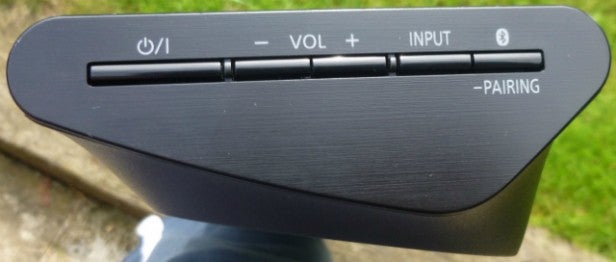
Build quality is excellent. Its black metal mesh gives it a solid, weighty quality, while the panels that cap each end sport an attractive brushed finish. On one of these panels you’ll find a discreet cluster of buttons, including volume, standby and input selection.
On the front edge of the soundbar is an LED panel that displays inputs, volume levels and menus, but because it faces upwards when laid flat you can’t see it from the sofa. That renders it virtually pointless, unless you mount it on the wall using the supplied brackets.
SEE ALSO: New TV Buying Guide
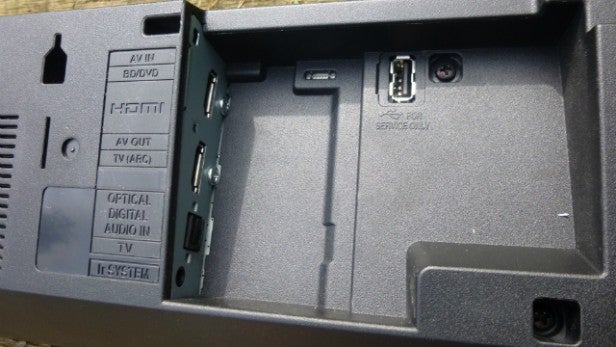
On the back is a decent selection of sockets, including an HDMI input and ARC-compatible HDMI output that pass through 3D but not 4K (that’s only found on the SC-HTB880). There’s an optical input and a port for the IR blaster that passes on TV remote commands if the soundbar blocks the receiver (however unlikely that is), although it only works with Panasonic TVs. Sadly the USB port is for service use only and surprisingly there’s no 3.5mm minijack input.
The subwoofer is fairly large and attractively styled in a combination of gloss and matt black, although build quality is disappointing – particularly the plastic base. Usually there’s an on/off switch on the back too, but not here.
Panasonic SC-HTB480 – Features
Of greatest interest to music fans is the inclusion of Bluetooth, which offers easy streaming from smartphones, while NFC made pairing our Sony NWZ-F886 Android media player a painless process.
The soundbar musters 250W of power, with 60W per channel for the speakers and 130W for the sub, which certainly should be plenty for a powerful sound. There’s on-board decoding for Dolby Digital and DTS as well as support for multichannel LPCM. Dolby Virtual Speaker processing aims to deliver a surround effect through the bar’s stereo speakers.
Panasonic’s usual plethora of sound modes is present and correct, including a 3D Surround mode that intertwines with Dolby Virtual Speaker to expand the soundstage in all directions. These are turned on by default – to turn them off you have to select ‘stereo’ mode.
3D Clear Mode Dialog aims to make audio sound like it’s coming more directly from the TV screen, while H.Bass bolsters low frequencies. You can also adjust dialogue and subwoofer levels using the dedicated level controls, and there are six sound modes to play with – Standard, Stadium, Music, Cinema, News and Stereo.
Panasonic SC-HTB480 – Operation
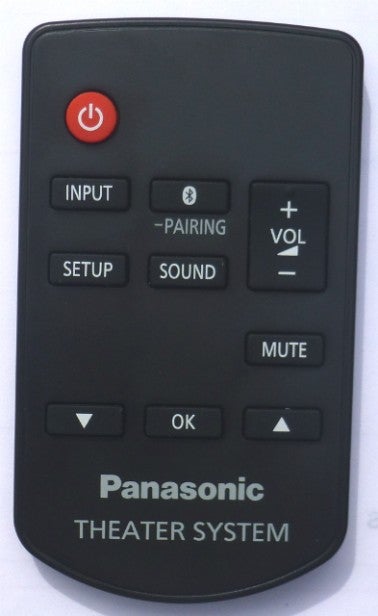 The SC-HTB480 comes with a mini remote that feels cheap and plasticky – a far cry from the excellent full-size handset supplied with the LG NB4540. It’s also a prime candidate for permanent residency down the back of the sofa. But the layout is fine and all the keys are clearly marked.
The SC-HTB480 comes with a mini remote that feels cheap and plasticky – a far cry from the excellent full-size handset supplied with the LG NB4540. It’s also a prime candidate for permanent residency down the back of the sofa. But the layout is fine and all the keys are clearly marked.
There are dedicated buttons for the setup menu and sound modes, both of which are displayed on the front panel and can be explored using the up, down and OK keys on the remote. In the Sound menu, you can activate the various presets or adjust the dialogue and subwoofer levels, but these upward-facing menus aren’t much use when you’re slumped on the sofa.
Panasonic SC-HTB480 – Performance
With the soundbar perched on our TV stand and the subwoofer in close proximity on the floor, we fired up Transformers on Blu-ray, and the ‘bar does exactly what it sets out to, namely delivering louder and bassier sound than any flatscreen TV is capable of.
So when Blackout attacks the Qatar Army base, explosions and gunshots sound big and forceful. Dolby Virtual Speaker doesn’t offer much evidence of surround sound, as is so often the case with virtual surround modes, but there is a vague sense of added width.
Skip to the scrap between Optimus Prime and Megatron at the movie’s climax and the thumping heavy metal soundtrack, exploding buildings and machine gun fire are delivered with gusto.
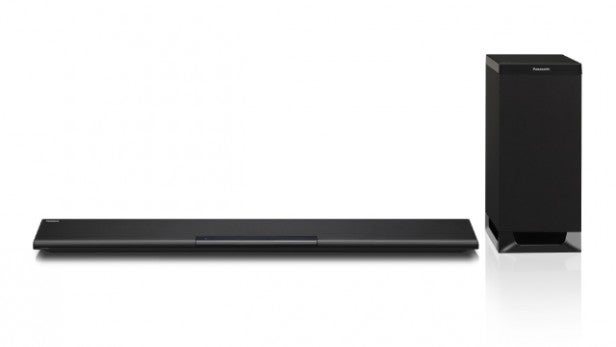
The subwoofer does a decent job too. Every bang and boom is accompanied by a thick ‘whomp’ of bass that adds depth and impact. It lacks the out-and-out slam and control of more accomplished (and expensive) subs but there’s a reasonable display of agility when blasting out rapid gun shots or stomping footsteps. We would recommend turning the subwoofer down to its lowest setting though – anything higher is too boomy.
Another of the Panasonic’s positives is its clear, prominent dialogue reproduction – then again, with two different dialogue boosters on board you were never in danger of missing any speech.
So far so good, but the Panasonic’s loud, bassy performance flatters to deceive. Sure, it’s terrific compared with weedy TV speakers, but when you start weighing it up against the competition the picture isn’t quite as rosy. This is not the high-fidelity sound of the Canton DM50 or Wharfedale Vista 100, nor the super-detailed presentation of the LG NB4540.
The SC-HTB480’s timbre errs more on the brash side, which makes for a slightly uncomfortable and fatiguing listen after a while with the volume up loud. We switched over to The Desolation of Smaug and it exposes the Panasonic even more cruelly – snarling Orcs, clanking swords and roaring dragons have a hard edge, which will frequently have you reaching for the volume controls. The soundbars listed above, particularly the Canton and Wharfedale, offer a smoother, easier presentation of these midrange and high-frequency effects.
We’d also recommend leaving 3D Clear Mode Dialog switched on at all times. Without it the soundstage is too narrow and muffled, but once activated everything feels more open.
The soundbar’s hard presentation makes Bluetooth-beamed music sound a little synthetic. Certain genres expose this more than others – for example, jazz tunes with soaring sax and trumpet solos sound thin and reedy, but electronic genres like dance or hip-hop fare better, although it’s even more important here that you keep the subwoofer level in check.
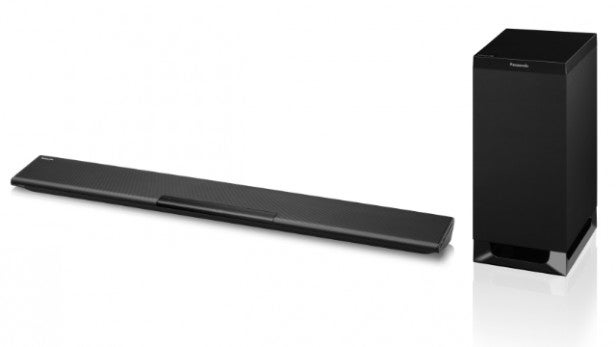
Should I buy the Panasonic SC-HTB480?
The SC-HTB480 offers an appealing range of features, a discreet, robust design and audio that’ll knock your TV’s speakers into a cocked hat, but there are soundbars on the market that deliver a more satisfying performance, such as the Wharfedale Vista 100, Denon DHT-S514 and Canton’s DM50 soundbase.
The Panasonic’s brash sound becomes uncomfortable at high volumes, plus the boomy sub requires careful integration. Little things, like the awkward sockets, upward-facing LED display and dinky remote, don’t help justify the asking price either.
Verdict
A good-looking, well-made soundbar system with some eye-catching features but its brash sound quality doesn’t quite cut the mustard.
Next, check out your other options in our Best soundbars
Trusted Score
Score in detail
-
Performance 7
-
Features 8
-
Value 7
-
Sound Quality 7
-
Design 8
Features
| 3D Ready | Yes |
| Number of Speakers | 2 |
| Supported Channels | 2.1 |
| DVD Player | No |
| Blu-ray player | No |
| Audio Processing | Dolby Virtual Speaker |
| Dolby Digital | Yes |
| DTS | Yes |
| Dolby Pro Logic II | Yes |
| Dolby TrueHD | No |
| DTS Master Audio HD | No |
Connectors
| HDMI Input | 1 |
| HDMI Output | 1 |
| S/PDIF Optical In | 1 |
| Subwoofer Out | Wireless |
| Power (Watt) | 250W |
Physical Specifications
| Height (Millimeter) | 53mm |
| Width (Millimeter) | 950mm |
| Depth (Millimeter) | 110mm |
| Weight (Gram) | 2.5kg |

